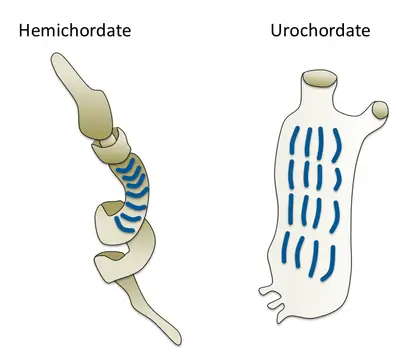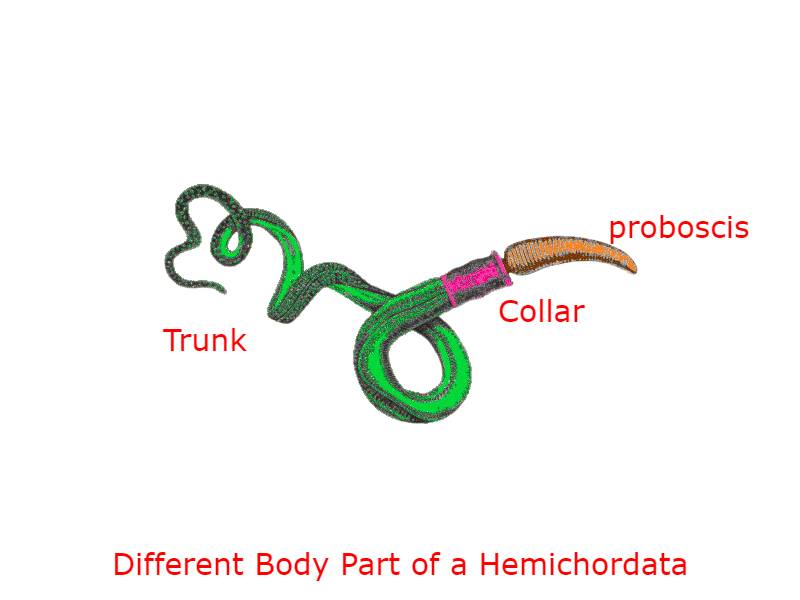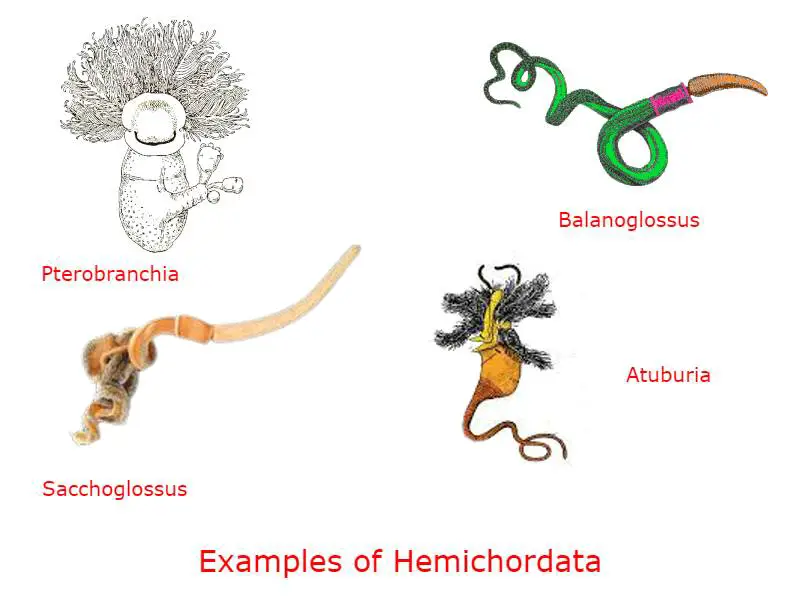Hemichordata is a small group of animals, having around 80 species of soft-bodied animals and they are exclusively marine and show great power of regeneration. We will discuss the general characteristics features of the subphylum Hemichordata, their classification, and examples.
Table of Contents
Characteristics Features of Hemichordata:
- They live in marine environment, they can live in colonial form or in solitary form, they generally live in coastal areas under the stones, in the sea weeds or in burrows made of sand or mud.
- They are triploblastic, body show bilateral symmetry, body is soft and fragile, fragments of body parts can give rise to new individuals.
- Body is unsegmented, vermiform or slender in shape, body is divided into three parts, anterior proboscis, middle collar and posterior trunk.
- Body cavity of coelom is enterocoelous type, during embryonic development the archenteron form the coelom and the coelom is not single, the coelom in proboscis, collar and trunk is not connected to each other, they are separated from each other. The coelom are present in different parts of body remain without any connection.
- Body Wall is thick due to thick muscular layer, body wall have only epidermis, dermis layer is absent. Due to glandular cells of epidermis the skin is smooth and secret mucous.
- Digestive system is complete, opening at mouth and end in anus, alimentary canal is either straight or U shaped.
- Difference shaped proboscis are found in them, in majority the proboscis is conical shaped, in some cases the proboscis is shield shaped and in some cases it is disc shaped.
- The collar is short, in some cases the collar have branched hollow cilated tentacles like structure which helps them to capture food.
- In buccal cavity the dorsal wall produce a hollow tubular outgrowth which project inside proboscis coelom known as buccal diverticulum which was known as notochord in previous time.
- In trunk region there are longitudinal rows present dorso-laterally in which gill slits are open outside through gill pores, the gill slits maybe one pairs to several pairs.
- In Circulatory system there are no such respiratory pigment, in the body there are only two major blood vessels, one dorsal vessel and another one is ventral vessel, cardiac sac or heart vesicles present dorsally.
- Excretion occur through proboscis gland or glomerulus present in proboscis coelom.
- Nervous systems is not well developed, nerve fibres and nerve cells present under the epidermis layer, so nervous system is epidermal in Hemichordata. The nervous tissue in epidermis show more thickness along the mid-dorsal line and mid-ventral line form dorsal and ventral cord. Dorsal cord in collar region show a hollow cavity known as neurocoel which show great resemblance with the dorsal hollow nervecord in Chordata.
- Reproduction generally occurs through sexual reproduction, male and female are separate and the gonad present in pairs, in some cases only one gonad is present. Fertilization occur in sea water, development maybe direct or indirect with free swimming Tornaria larva.
- They show great power of regeneration, in some cases asexual reproduction occur through budding, body fragments of their body can produce whole part of their body.

Classification of Hemichordata:
We will mainly focus on two important classes of subphylum Hemichordata, Enteropneusta, and Pterobranchia along with some other classes of Hemichordata.
Class:1 Enteropneusta:
- This class include the vermiform, burrowing, acorn worm or tongue worm, they generally live in solitary or colonial form.
- Collar have no tentacular structure or lophophore, proboscis maybe tapering or conical in shape.
- Alimentary canal is straight so the mouth and anus open at opposite ends of the body, they collect food through ciliary feeding mechanism.
- Gill slits present in pairs and numerous in number, number of gill slits increase with the increase in age of the animal and the gill slits are supported by U shaped endoskeleton.
- Reproduction generally occurs through sexual reproduction, gonads present in large numbers, development stage have Tornaria larva.
Class:2 Pterobranchia:
- They maybe solitary or maybe present in colonial form in the substratum of sea floor, in colonial form stalk like structure present which gives them attachment to the substratum.
- Collar have tentacular structure or lophophore and the proboscis is shield shaped.
- Alimentary canal is U shaped in them so the mouth and anus open side by side on dorsal side of the body.
- Reproduction is sexual, single or one pair of gonad is present, in some cases asexual reproduction occur through the process of budding.

Order:1 Rhabdopleurida:
- Collar is short and have two tentaculated arms.
- They live in colonial form and each individual zooids are connected to each other by stolon.
- In trunk region there are no gill slits present, gonads is single and this class have a single genus, Rhabdopleura.
Order:2 Cephalodiscida:
- They maybe live in solitary state or maybe present on a gelatinous matrix in colonial form.
- Collar region have large number of tentaculated arms and in trunk region only one pair of gill slits present.
- They generally reproduce through sexual reproduction and gonad is two in number, some important members of this order are Cephalodiscus and Atubaria.
Class:3 Planctosphearoidea:
- In this class a special tornaria larva like small, rounded, transparent larval stage is observed.
- In larval stage a special type of cilated bands are present and alimentary canal is L shaped in this order.
Class:4 Graptolia:
- They are extinct Hemichordate and the fossil graptolites represent this order.
- This Hemichordata order was abundant in Ordovician and Silurian period, they generally live in colonial form.
Examples of Hemichordata:

- Ptychodera: They almost similar to Balanoglossus in various aspects but the collar and proboscis in Ptychodera is much smaller than Balanoglossus. Like Balanoglossus they have gonads in genital wings in trunk region.
- Cephalodiscus: They live in colonial form in the gelatinous matrix known as coenocium which are attached with the surface of sea floor. Zooids are not connected to each other through any direct link, body is divided into three parts, shield shaped proboscis, collar and trunk. The shield shaped proboscis cover the mouth opening and the proboscis coelom is open outside through two proboscis pores. The collar region have 8-16 lophophore and on top of each tentacles a knob like glandular structure present. Alimentary canal is U shaped, mouth open at ventral side while the anus open on dorsal side.
- Atubaria: They live in colonial form and each zooids are 1 to 5 mm in size, collar have four pairs of tentaculated arms.
- Rhabdopleura: They live in colonial form, several horizontal and vertical gelatinous tube form colonial form coenocium attached with the hard substratum on the sea floor. Inside vertical gelatinous tube small sized zooids are present and posterior end of each zooids are connected to a common black stolon through living connections.
- Saccoglossus: Posterior end of collar cover first few pairs of gill slits, genital wings and hepatic caeca absent in them. Development is direct and do not show free swimming larva tornaria, they show much similarity with Balanoglossus.
Reference Characteristics Features of Hemichordata
Detailed Information on
Hi Everyone!!! Welcome to Imaluop. Imaluop always try to learn some new and he want to share to other people. Here we will try to learn various topics on Science, specially on Biological Sciences.